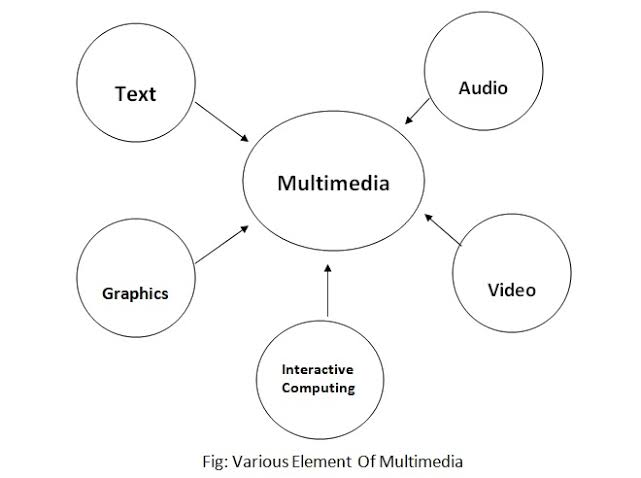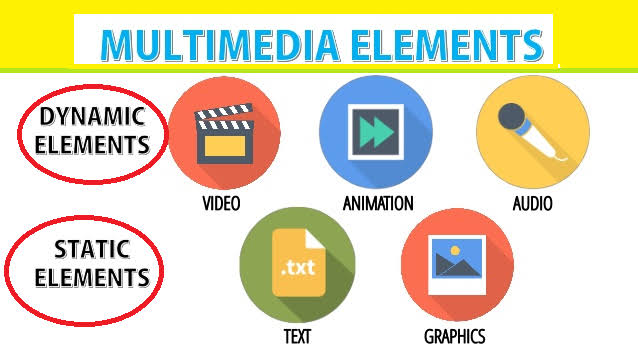

- Trending Categories
Data Structure
Networking
RDBMS
Operating System
Java
iOS
HTML
CSS
Android
Python
C Programming
C++
C#
MongoDB
MySQL
Javascript
PHP
Physics
Chemistry
Biology
Mathematics
English
Economics
Psychology
Environmental Science
Social Studies
Fashion Studies
Legal Studies
- Selected Reading
- UPSC IAS Exams Notes
- Developer's Best Practices
- articles and Answers
- Effective Resume Writing
- HR Interview articles
- Computer Glossary
- Who is Who
What is Multimedia & Explain It's Types
Multimedia is a term that refers to the combination of different types of media elements such as text, images, audio, video, and animations to create a single message. It is the use of various forms of content to convey information or entertainment to an audience. Multimedia is a powerful communication tool that has revolutionized the way we interact with information, entertainment, and communication. This article will explore the what is multimedia, different types of multimedia, its components, applications, advantages, and disadvantages in detail.

Types of Multimedia
Multimedia can be classified into different types based on the type of content used. Some of the most common types of multimedia are:

1. Text-Based Multimedia: This type of multimedia includes text, fonts, and typography. It is used to create documents, presentations, and web pages.
2. Image-Based Multimedia: This type of multimedia includes still images and photographs. It is used for creating graphics, logos, and illustrations.
3. Audio-Based Multimedia: This type of multimedia includes sound, music, and voiceovers. It is used for creating podcasts, music videos, and sound effects.
4. Video-Based Multimedia: This type of multimedia includes moving images and animations. It is used for creating movies, TV shows, and animated videos.
5. Interactive Multimedia: This type of multimedia includes games, simulations, and virtual reality. It is used for creating educational content, training programs, and entertainment.
Components of Multimedia
Multimedia is composed of various elements, each with its unique function. The components of multimedia are:

1. Hardware: The physical equipment used to create and deliver multimedia content, such as cameras, microphones, speakers, and computers.
2. Software: The programs used to create, edit, and publish multimedia content, such as Adobe Photoshop, Premiere Pro, and After Effects.
3. Content: The actual media elements used to create multimedia content, such as text, images, audio, and video.
• Text
Characters are used to form words, phrases, and paragraphs in the text. Text appears in all multimedia creations of some kind. The text can be in a variety of fonts and sizes to match the multimedia software’s professional presentation. Text in multimedia systems can communicate specific information or serve as a supplement to the information provided by the other media.
• Video
Photographic images that appear to be in full motion and are played back at speeds of 15 to 30 frames per second. The term video refers to a moving image that is accompanied by sound, such as a television picture. Of course, text can be included in videos, either as captioning for spoken words or as text embedded in an image, as in a slide presentation. The following programs are widely used to view videos: Real Player, Window Media Player, etc.
• Audio
Any sound, whether it’s music, conversation, or something else. Sound is the most serious aspect of multimedia, delivering the joy of music, special effects, and other forms of entertainment. Decibels are a unit of measurement for volume and sound pressure level. Audio files are used as part of the application context as well as to enhance interaction. Audio files must occasionally be distributed using plug-in media players when they appear within online applications and webpages. MP3, WMA, Wave, MIDI, and RealAudio are examples of audio formats. The following programs are widely used to view videos: Real Player, Window Media Player, etc.
4. Graphics - The multimedia program is appealing because of its graphics. People frequently find it difficult to read long passages of text on screens. As a result, visuals are frequently utilized instead of writing to convey ideas, give context, etc. Graphics can be of two different types:
- Bitmap - Bitmap images are authentic pictures that can be taken using tools like digital cameras or scanners. Bitmap pictures are often not modifiable. Memory use for bitmap pictures is high.
- Vector Graphics - Computers can draw vector graphics because they just need a little amount of memory. These images can be changed.
5. Delivery: The method used to distribute and display multimedia content, such as CD-ROMs, DVDs, websites, and streaming services.
Applications of Multimedia
Multimedia has a wide range of applications in various fields, including education, entertainment, marketing, and communication. Some of the most common applications of multimedia are:
1. Education: Multimedia is used to create interactive and engaging educational content, such as e-learning courses, tutorials, and educational games.
2. Entertainment: Multimedia is used to create various forms of entertainment, such as movies, TV shows, video games, and music videos.
3. Marketing: Multimedia is used for marketing purposes, such as creating promotional videos, advertisements, and product demonstrations.
4. Communication: Multimedia is used for communication purposes, such as video conferencing, webinars, and online meetings.
5. Fine Arts : Multimedia artists work in the fine arts, combining approaches employing many media and incorporating viewer involvement in some form. For example, a variety of digital mediums can be used to combine movies and operas.
Digital artist is a new word for these types of artists. Digital painters make digital paintings, matte paintings, and vector graphics of many varieties using computer applications.
6. Engineering
Multimedia is frequently used by software engineers in computer simulations for military or industrial training. It’s also used for software interfaces created by creative experts and software engineers in partnership. Only multimedia is used to perform all the minute calculations.
Advantages of Multimedia
1. Engaging: Multimedia is more engaging than traditional text-based content, as it incorporates various forms of media elements that stimulate multiple senses.
2. Interactive: Multimedia is interactive, allowing users to engage with the content, such as clicking on links, playing games, and watching videos.
3. Memorable: Multimedia is more memorable than text-based content, as it uses various forms of media elements that make the content more memorable.
4. Versatile: Multimedia is versatile, as it can be used for various purposes, such as education, entertainment, marketing, and communication.
5. Accessible: Multimedia is accessible, as it can be delivered through various mediums, such as websites, CDs, DVDs, and streaming services.
Disadvantages of Multimedia
1. Costly: Creating multimedia content can be expensive, as it requires specialized equipment, software, and expertise.
2. Time-consuming: Creating multimedia content is time-consuming, as it involves various stages, such as planning, designing, and editing.
3. Technical difficulties: Multimedia content can be affected by technical difficulties, such as slow internet connections, compatibility issues, and software bugs.
4. Accessibility: While multimedia is generally accessible, some users with disabilities may face barriers to accessing certain types of content, such as videos without captions or audio without transcripts.
5. Distraction: Multimedia can be distracting, particularly if the content is poorly designed or overloaded with too many media elements.
6. Quality issues: Creating high-quality multimedia content requires expertise and experience. Poorly designed or low-quality content can harm a brand or message.
Conclusion
Multimedia has become an essential part of our daily lives, offering a wide range of applications in various fields. The combination of different media elements provides an engaging, interactive, and memorable experience that traditional text-based content cannot match. However, creating multimedia content can be costly and time-consuming, and technical difficulties can affect accessibility and user experience. Nonetheless, the advantages of multimedia outweigh the disadvantages, and the demand for multimedia content will continue to grow in the future.
ads




